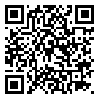Volume 27, Issue 2 (7-2021)
Back to this Issue |
Back to browse issues page
Download citation:
BibTeX | RIS | EndNote | Medlars | ProCite | Reference Manager | RefWorks
Send citation to:



BibTeX | RIS | EndNote | Medlars | ProCite | Reference Manager | RefWorks
Send citation to:
Shamsi A, Valizadeh L, Rahkar Farshi M, Asghari Jafarabadi M. Frequency of predisposing factors for the entry of foreign bodies into the ear, ingestion and aspiration in children under five years in Tabriz, 2019. Journal of Hayat 2021; 27 (2) :221-232
URL: http://hayat.tums.ac.ir/article-1-4160-en.html
URL: http://hayat.tums.ac.ir/article-1-4160-en.html
1- Dept. of Pediatric Nursing, School of Nursing and Midwifery, Tabriz University of Medical Sciences, Tabriz, Iran
2- Dept. of Pediatric Nursing, School of Nursing and Midwifery, Tabriz University of Medical Sciences, Tabriz, Iran ,valizadehl@tbzmed.ac.ir
3- Dept. of Statistics and Epidemiology, School of Medicine, Zanjan University of Medical Sciences, Zanjan, Iran; Center for the Development of Interdisciplinary Research in Islamic Sciences and Health Sciences, Tabriz University of Medical Sciences, Tabriz, Iran
2- Dept. of Pediatric Nursing, School of Nursing and Midwifery, Tabriz University of Medical Sciences, Tabriz, Iran ,
3- Dept. of Statistics and Epidemiology, School of Medicine, Zanjan University of Medical Sciences, Zanjan, Iran; Center for the Development of Interdisciplinary Research in Islamic Sciences and Health Sciences, Tabriz University of Medical Sciences, Tabriz, Iran
Abstract: (2323 Views)
Background & Aim: Structured description of pediatric medical emergencies requires the assessment and classification of underlying factors. The aim of study was to investigate frequency of predisposing factors for the entry of foreign bodies (FB) in the ear, ingestion and aspiration in children under five years in Tabriz.
Methods & Materials: This is a descriptive, cross-sectional study conducted through convenience sampling (n=245) in the ENT and emergency departments and the clinic of children's hospital in Tabriz, from March 2019 to June 2019. A researcher-made tool including the demographic characteristics form and questionnaire on predisposing factors was used to collect the data. Data was analyzed using the SPSS software version 21 through descriptive statistics.
Results: There were 137 (55.9%) cases of FB aspiration into the airways (upper and lower), and the highest was related to nose. FB in ear was 19.6% and in stomach was 19.2%. Clinical manifestations were pain (50.2%), no clinical signs (29.4%), and the rest were bleeding with pain, cough, shortness of breath, suffocation, wheezing, nausea, and vomiting. The place of event was at home (in living room) and in the evening and night time. FB types included objects, food stuff/snacks/nuts, beans and fruit cores, and toy pieces, and it is most likely to be seed, toy pieces, nuts, shirt buttons, and rosary beads.
Conclusion: Parental, child-related, and environmental predisposing factors were reported. Therefore, future studies are suggested to evaluate the contribution of each of three factors and to implement necessary educational, notification, and interventional measures.
Methods & Materials: This is a descriptive, cross-sectional study conducted through convenience sampling (n=245) in the ENT and emergency departments and the clinic of children's hospital in Tabriz, from March 2019 to June 2019. A researcher-made tool including the demographic characteristics form and questionnaire on predisposing factors was used to collect the data. Data was analyzed using the SPSS software version 21 through descriptive statistics.
Results: There were 137 (55.9%) cases of FB aspiration into the airways (upper and lower), and the highest was related to nose. FB in ear was 19.6% and in stomach was 19.2%. Clinical manifestations were pain (50.2%), no clinical signs (29.4%), and the rest were bleeding with pain, cough, shortness of breath, suffocation, wheezing, nausea, and vomiting. The place of event was at home (in living room) and in the evening and night time. FB types included objects, food stuff/snacks/nuts, beans and fruit cores, and toy pieces, and it is most likely to be seed, toy pieces, nuts, shirt buttons, and rosary beads.
Conclusion: Parental, child-related, and environmental predisposing factors were reported. Therefore, future studies are suggested to evaluate the contribution of each of three factors and to implement necessary educational, notification, and interventional measures.
Send email to the article author
| Rights and permissions | |
 |
This work is licensed under a Creative Commons Attribution-NonCommercial 4.0 International License. |






